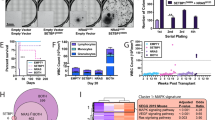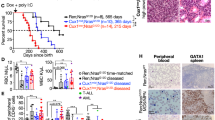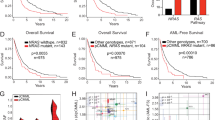Abstract
RAF kinase inhibitor protein (RKIP) is a negative regulator of the RAS-mitogen-activated protein kinase/extracellular signal-regulated kinase signaling cascade. We investigated its role in acute myeloid leukemia (AML), an aggressive malignancy arising from hematopoietic stem and progenitor cells (HSPCs). Western blot analysis revealed loss of RKIP expression in 19/103 (18%) primary AML samples and 4/17 (24%) AML cell lines but not in 10 CD34+ HSPC specimens. In in-vitro experiments with myeloid cell lines, RKIP overexpression inhibited cellular proliferation and colony formation in soft agar. Analysis of two cohorts with 103 and 285 AML patients, respectively, established a correlation of decreased RKIP expression with monocytic phenotypes. RKIP loss was associated with RAS mutations and in transformation assays, RKIP decreased the oncogenic potential of mutant RAS. Loss of RKIP further related to a significantly longer relapse-free survival and overall survival in uni- and multivariate analyses. Our data show that RKIP is frequently lost in AML and correlates with monocytic phenotypes and mutations in RAS. RKIP inhibits proliferation and transformation of myeloid cells and decreases transformation induced by mutant RAS. Finally, loss of RKIP seems to be a favorable prognostic parameter in patients with AML.
This is a preview of subscription content, access via your institution
Access options
Subscribe to this journal
Receive 12 print issues and online access
$259.00 per year
only $21.58 per issue
Buy this article
- Purchase on Springer Link
- Instant access to full article PDF
Prices may be subject to local taxes which are calculated during checkout





Similar content being viewed by others
References
Bennett JM, Catovsky D, Daniel MT, Flandrin G, Galton DA, Gralnick HR et al. Proposals for the classification of the acute leukaemias. French-American-British (FAB) co-operative group. Br J Haematol 1976; 33: 451–458.
Vardiman JW, Thiele J, Arber DA, Brunning RD, Borowitz MJ, Porwit A et al. The 2008 revision of the World Health Organization (WHO) classification of myeloid neoplasms and acute leukemia: rationale and important changes. Blood 2009; 114: 937–951.
Dohner H, Estey EH, Amadori S, Appelbaum FR, Buchner T, Burnett AK et al. Diagnosis and management of acute myeloid leukemia in adults: recommendations from an international expert panel, on behalf of the European LeukemiaNet. Blood 2010; 115: 453–474.
Sill H, Olipitz W, Zebisch A, Schulz E, Wolfler A . Therapy-related myeloid neoplasms: pathobiology and clinical characteristics. Br J Pharmacol 2011; 162: 792–805.
Zebisch A, Czernilofsky AP, Keri G, Smigelskaite J, Sill H, Troppmair J . Signaling through RAS-RAF-MEK-ERK: from basics to bedside. Curr Med Chem 2007; 14: 601–623.
Steelman LS, Franklin RA, Abrams SL, Chappell W, Kempf CR, Basecke J et al. Roles of the Ras/Raf/MEK/ERK pathway in leukemia therapy. Leukemia 2011; 25: 1080–1094.
Steelman LS, Abrams SL, Whelan J, Bertrand FE, Ludwig DE, Basecke J et al. Contributions of the Raf/MEK/ERK, PI3K/PTEN/Akt/mTOR and Jak/STAT pathways to leukemia. Leukemia 2008; 22: 686–707.
Tyner JW, Erickson H, Deininger MW, Willis SG, Eide CA, Levine RL et al. High-throughput sequencing screen reveals novel, transforming RAS mutations in myeloid leukemia patients. Blood 2009; 113: 1749–1755.
Yeung K, Seitz T, Li S, Janosch P, McFerran B, Kaiser C et al. Suppression of Raf-1 kinase activity and MAP kinase signalling by RKIP. Nature 1999; 401: 173–177.
Yeung KC, Rose DW, Dhillon AS, Yaros D, Gustafsson M, Chatterjee D et al. Raf kinase inhibitor protein interacts with NF-kappaB-inducing kinase and TAK1 and inhibits NF-kappaB activation. Mol Cell Biol 2001; 21: 7207–7217.
Granovsky AE, Rosner MR . Raf kinase inhibitory protein: a signal transduction modulator and metastasis suppressor. Cell Res 2008; 18: 452–457.
Wu K, Bonavida B . The activated NF-kappaB-Snail-RKIP circuitry in cancer regulates both the metastatic cascade and resistance to apoptosis by cytotoxic drugs. Crit Rev Immunol 2009; 29: 241–254.
Fu Z, Smith PC, Zhang L, Rubin MA, Dunn RL, Yao Z et al. Effects of raf kinase inhibitor protein expression on suppression of prostate cancer metastasis. J Natl Cancer Inst 2003; 95: 878–889.
Hagan S, Al-Mulla F, Mallon E, Oien K, Ferrier R, Gusterson B et al. Reduction of Raf-1 kinase inhibitor protein expression correlates with breast cancer metastasis. Clin Cancer Res 2005; 11: 7392–7397.
Lee HC, Tian B, Sedivy JM, Wands JR, Kim M . Loss of Raf kinase inhibitor protein promotes cell proliferation and migration of human hepatoma cells. Gastroenterology 2006; 131: 1208–1217.
Minoo P, Zlobec I, Baker K, Tornillo L, Terracciano L, Jass JR et al. Loss of raf-1 kinase inhibitor protein expression is associated with tumor progression and metastasis in colorectal cancer. Am J Clin Pathol 2007; 127: 820–827.
Zebisch A, Haller M, Hiden K, Goebel T, Hoefler G, Troppmair J et al. Loss of RAF kinase inhibitor protein is a somatic event in the pathogenesis of therapy-related acute myeloid leukemias with C-RAF germline mutations. Leukemia 2009; 23: 1049–1053.
Zebisch A, Staber PB, Delavar A, Bodner C, Hiden K, Fischereder K et al. Two transforming C-RAF germ-line mutations identified in patients with therapy-related acute myeloid leukemia. Cancer Res 2006; 66: 3401–3408.
Wolfler A, Erkeland SJ, Bodner C, Valkhof M, Renner W, Leitner C et al. A functional single-nucleotide polymorphism of the G-CSF receptor gene predisposes individuals to high-risk myelodysplastic syndrome. Blood 2005; 105: 3731–3736.
Drexler HG, Dirks WG, Matsuo Y, MacLeod RA . False leukemia-lymphoma cell lines: an update on over 500 cell lines. Leukemia 2003; 17: 416–426.
Valk PJ, Verhaak RG, Beijen MA, Erpelinck CA, Barjesteh van Waalwijk van Doorn-Khosrovani S, Boer JM et al. Prognostically useful gene-expression profiles in acute myeloid leukemia. N Engl J Med 2004; 350: 1617–1628.
Fried I, Bodner C, Pichler MM, Lind K, Beham-Schmid C, Quehenberger F et al. Frequency, onset and clinical impact of somatic DNMT3A mutations in therapy-related and secondary acute myeloid leukemia. Haematologica 2012; 97: 246–250.
Zebisch A, Linkesch W, Sill H . Bedside RNA stabilizing kit systems for gene expression analysis of acute leukemias: influence of non-neoplastic white blood cells. Leukemia 2005; 19: 136–137.
Kuznetsov AV, Smigelskaite J, Doblander C, Janakiraman M, Hermann M, Wurm M et al. Survival signaling by C-RAF: mitochondrial reactive oxygen species and Ca2+ are critical targets. Mol Cell Biol 2008; 28: 2304–2313.
Maclaren A, Clark W, Black EJ, Gregory D, Fujii H, Gillespie DA . v-Jun stimulates both cdk2 kinase activity and G1/S progression via transcriptional repression of p21 CIP1. Oncogene 2003; 22: 2383–2395.
Matallanas D, Romano D, Yee K, Meissl K, Kucerova L, Piazzolla D et al. RASSF1A elicits apoptosis through an MST2 pathway directing proapoptotic transcription by the p73 tumor suppressor protein. Mol Cell 2007; 27: 962–975.
Beach S, Tang H, Park S, Dhillon AS, Keller ET, Kolch W et al. Snail is a repressor of RKIP transcription in metastatic prostate cancer cells. Oncogene 2008; 27: 2243–2248.
Raepple D, von Lintig F, Zemojtel T, Duchniewicz M, Jung A, Lubbert M et al. Determination of Ras-GTP and Ras-GDP in patients with acute myelogenous leukemia (AML), myeloproliferative syndrome (MPS), juvenile myelomonocytic leukemia (JMML), acute lymphocytic leukemia (ALL), and malignant lymphoma: assessment of mutational and indirect activation. Ann Hematol 2009; 88: 319–324.
Garte SJ, Currie DD, Troll W . Inhibition of H-ras oncogene transformation of NIH3T3 cells by protease inhibitors. Cancer Res 1987; 47: 3159–3162.
Palanisamy N, Ateeq B, Kalyana-Sundaram S, Pflueger D, Ramnarayanan K, Shankar S et al. Rearrangements of the RAF kinase pathway in prostate cancer, gastric cancer and melanoma. Nat Med 2010; 16: 793–798.
Tallman MS, Kim HT, Paietta E, Bennett JM, Dewald G, Cassileth PA et al. Acute monocytic leukemia (French-American-British classification M5) does not have a worse prognosis than other subtypes of acute myeloid leukemia: a report from the Eastern Cooperative Oncology Group. J Clin Oncol 2004; 22: 1276–1286.
Pulsoni A, Iacobelli S, Bernardi M, Borgia M, Camera A, Cantore N et al. M4 acute myeloid leukemia: the role of eosinophilia and cytogenetics in treatment response and survival. The GIMEMA experience. Haematologica 2008; 93: 1025–1032.
Platanias LC . Map kinase signaling pathways and hematologic malignancies. Blood 2003; 101: 4667–4679.
Dangi-Garimella S, Yun J, Eves EM, Newman M, Erkeland SJ, Hammond SM et al. Raf kinase inhibitory protein suppresses a metastasis signalling cascade involving LIN28 and let-7. EMBO J 2009; 28: 347–358.
Chatterjee D, Bai Y, Wang Z, Beach S, Mott S, Roy R et al. RKIP sensitizes prostate and breast cancer cells to drug-induced apoptosis. J Biol Chem 2004; 279: 17515–17523.
Baritaki S, Katsman A, Chatterjee D, Yeung KC, Spandidos DA, Bonavida B . Regulation of tumor cell sensitivity to TRAIL-induced apoptosis by the metastatic suppressor Raf kinase inhibitor protein via Yin Yang 1 inhibition and death receptor 5 up-regulation. J Immunol 2007; 179: 5441–5453.
Baritaki S, Chapman A, Yeung K, Spandidos DA, Palladino M, Bonavida B . Inhibition of epithelial to mesenchymal transition in metastatic prostate cancer cells by the novel proteasome inhibitor, NPI-0052: pivotal roles of Snail repression and RKIP induction. Oncogene 2009; 28: 3573–3585.
Yeung K, Janosch P, McFerran B, Rose DW, Mischak H, Sedivy JM et al. Mechanism of suppression of the Raf/MEK/extracellular signal-regulated kinase pathway by the raf kinase inhibitor protein. Mol Cell Biol 2000; 20: 3079–3085.
Kinoshita T, Yokota T, Arai K, Miyajima A . Suppression of apoptotic death in hematopoietic cells by signalling through the IL-3/GM-CSF receptors. EMBO J 1995; 14: 266–275.
Kinoshita T, Yokota T, Arai K, Miyajima A . Regulation of Bcl-2 expression by oncogenic Ras protein in hematopoietic cells. Oncogene 1995; 10: 2207–2212.
Houben R, Vetter-Kauczok CS, Ortmann S, Rapp UR, Broecker EB, Becker JC . Phospho-ERK staining is a poor indicator of the mutational status of BRAF and NRAS in human melanoma. J Invest Dermatol 2008; 128: 2003–2012.
Braun BS, Tuveson DA, Kong N, Le DT, Kogan SC, Rozmus J et al. Somatic activation of oncogenic Kras in hematopoietic cells initiates a rapidly fatal myeloproliferative disorder. Proc Natl Acad Sci USA 2004; 101: 597–602.
Chan IT, Kutok JL, Williams IR, Cohen S, Kelly L, Shigematsu H et al. Conditional expression of oncogenic K-ras from its endogenous promoter induces a myeloproliferative disease. J Clin Invest 2004; 113: 528–538.
Cutts BA, Sjogren AK, Andersson KM, Wahlstrom AM, Karlsson C, Swolin B et al. Nf1 deficiency cooperates with oncogenic K-RAS to induce acute myeloid leukemia in mice. Blood 2009; 114: 3629–3632.
Karreth FA, Tuveson DA . Modelling oncogenic Ras/Raf signalling in the mouse. Curr Opin Genet Dev 2009; 19: 4–11.
Mardis ER, Ding L, Dooling DJ, Larson DE, McLellan MD, Chen K et al. Recurring mutations found by sequencing an acute myeloid leukemia genome. N Engl J Med 2009; 361: 1058–1066.
Haferlach C, Dicker F, Kohlmann A, Schindela S, Weiss T, Kern W et al. AML with CBFB-MYH11 rearrangement demonstrate RAS pathway alterations in 92% of all cases including a high frequency of NF1 deletions. Leukemia 2010; 24: 1065–1069.
Krivtsov AV, Twomey D, Feng Z, Stubbs MC, Wang Y, Faber J et al. Transformation from committed progenitor to leukaemia stem cell initiated by MLL-AF9. Nature 2006; 442: 818–822.
Wojiski S, Guibal FC, Kindler T, Lee BH, Jesneck JL, Fabian A et al. PML-RARalpha initiates leukemia by conferring properties of self-renewal to committed promyelocytic progenitors. Leukemia 2009; 23: 1462–1471.
Guibal FC, Alberich-Jorda M, Hirai H, Ebralidze A, Levantini E, Di Ruscio A et al. Identification of a myeloid committed progenitor as the cancer-initiating cell in acute promyelocytic leukemia. Blood 2009; 114: 5415–5425.
Cozzio A, Passegue E, Ayton PM, Karsunky H, Cleary ML, Weissman IL . Similar MLL-associated leukemias arising from self-renewing stem cells and short-lived myeloid progenitors. Genes Dev 2003; 17: 3029–3035.
Huntly BJ, Shigematsu H, Deguchi K, Lee BH, Mizuno S, Duclos N et al. MOZ-TIF2, but not BCR-ABL, confers properties of leukemic stem cells to committed murine hematopoietic progenitors. Cancer Cell 2004; 6: 587–596.
Bowen DT, Frew ME, Hills R, Gale RE, Wheatley K, Groves MJ et al. RAS mutation in acute myeloid leukemia is associated with distinct cytogenetic subgroups but does not influence outcome in patients younger than 60 years. Blood 2005; 106: 2113–2119.
Niemeyer CM, Kratz CP . Paediatric myelodysplastic syndromes and juvenile myelomonocytic leukaemia: molecular classification and treatment options. Br J Haematol 2008; 140: 610–624.
Emanuel PD . Juvenile myelomonocytic leukemia and chronic myelomonocytic leukemia. Leukemia 2008; 22: 1335–1342.
Schlenk RF, Dohner K, Krauter J, Frohling S, Corbacioglu A, Bullinger L et al. Mutations and treatment outcome in cytogenetically normal acute myeloid leukemia. N Engl J Med 2008; 358: 1909–1918.
Damm F, Heuser M, Morgan M, Wagner K, Gorlich K, Grosshennig A et al. Integrative prognostic risk score in acute myeloid leukemia with normal karyotype. Blood 2011; 117: 4561–4568.
Falini B, Sportoletti P, Martelli MP . Acute myeloid leukemia with mutated NPM1: diagnosis, prognosis and therapeutic perspectives. Curr Opin Oncol 2009; 21: 573–581.
Acknowledgements
This work was dedicated in loving memory to Astrid Hwaletz. We thank Werner Linkesch for continuing research support. This study was supported by grants from Land Steiermark (for AZ and HS), Leukämiehilfe Steiermark (for HS), FWF-MCBO (for JT), ÖKH-KG/Tirol (for JT), Cancer Research UK (for AZ and WK) and Science Foundation Ireland under Grant No. 06/CE/B1129 (for AZ and WK). AZ was further supported by an EMBO long-term fellowship.
Author contributions
AZ designed the research and performed the experiments, collected, analyzed and interpreted the data and wrote the manuscript; KL, OW, MH, CB, IF, AD, DP, DM, OR and KB performed the experiments and collected the data; FQ performed statistical analysis; ET and RD provided key research tools, collected, analyzed and interpreted the data; and AW, WK, JT and HS designed the study, collected, analyzed and interpreted the data and wrote the manuscript.
Author information
Authors and Affiliations
Corresponding author
Ethics declarations
Competing interests
The authors declare no conflict of interest.
Additional information
Supplementary Information accompanies the paper on the Leukemia website
Supplementary information
Rights and permissions
About this article
Cite this article
Zebisch, A., Wölfler, A., Fried, I. et al. Frequent loss of RAF kinase inhibitor protein expression in acute myeloid leukemia. Leukemia 26, 1842–1849 (2012). https://doi.org/10.1038/leu.2012.61
Received:
Revised:
Accepted:
Published:
Issue Date:
DOI: https://doi.org/10.1038/leu.2012.61
Keywords
This article is cited by
-
Micro-RNA-125a mediates the effects of hypomethylating agents in chronic myelomonocytic leukemia
Clinical Epigenetics (2021)
-
Transcriptional drug repositioning and cheminformatics approach for differentiation therapy of leukaemia cells
Scientific Reports (2021)
-
Effects of Raf kinase inhibitor protein expression on pancreatic cancer cell growth and motility: an in vivo and in vitro study
Journal of Cancer Research and Clinical Oncology (2016)
-
Deletion of SPRY4 is a frequent event in secondary acute myeloid leukemia
Annals of Hematology (2015)
-
Expression of RKIP in chronic myelogenous leukemia K562 cell and inhibits cell proliferation by regulating the ERK/MAPK pathway
Tumor Biology (2014)



